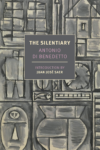The Infinite Future is a book about the promises that books make. In it, aspiring Mormon writer Daniel Laszlo gets a Young Religious Novelist Grant to produce his first manuscript for publication. To do so, he will go back to Brazil, where he served as a missionary not long before.
But Daniel finds, almost immediately upon arrival, that he cannot write. “I’d lost my missionary zeal long before and had failed to replace it with anything more compelling,” he tells us. “Failure encroached from all sides.”
The Infinite Future is also a book about failure: what it looks like, how to fend it off. And what it might mean to embrace it. Daniel soon picks up the trail of failed science fiction writer Eduard Salgado-Mackenzie, thanks to an obsessed São Paulo librarian (and failed journalist) named Sérgio Antunes. Sérgio gives Daniel a “twofold mission”:
First, translate the stories into English. You need to familiarize yourself intimately with the stories’ contents, and I can think of no better way to do so than translation. Second, you’re going to search the texts for clues pertaining to Salgado-MacKenzie’s biography and potential current whereabouts.
In other words, Daniel must deduce an absent author from his prose. Literary intimacy being best achieved through active intervention — nay, conversion — Daniel sets about his task.
Let’s think, for a moment, about that task. Daniel falls in love with the stories Sérgio provides for him. He comes to hope that by translating and tracking down their author, he himself will be transformed. He even comes to hope against hope for some version of transcendence.
Religious texts offer alternatives to their readers’ present worlds; Salgado-MacKenzie’s deft interplanetary heroine Captain Irena Sertôrian guides her readers through world after world. To visit another world and glean its wisdom and come back with it — that is the task of the translator. As translation sensation Elena Ferrante writes in her most recent column in The Guardian (translated by Ann Goldstein):
Translators transport nations into other nations; they are the first to reckon with distant modes of feeling. Even their mistakes are evidence of a positive force. Translation is our salvation: it draws us out of the well in which, entirely by chance, we are born.
Yet Ferrante’s “evidence of a positive force” also returns us to failure. Deborah Smith, whose translation from Korean of Han Kang’s The Vegetarian won the 2016 Man Booker International Prize, puts forward “a few propositions” in an essay published in The Los Angeles Review of Books last month on the topic of translation. Smith stresses that “change is not betrayal” when it comes to translation, and that in any case “no translation is definitive — it’s simply a way to ‘Fail again. Fail better.’” Translation’s inherent dynamism leaves much room for hope: there will be infinite opportunities, infinite choices — even mistakes — to get to make.
The Infinite Future is filled to the brim with failures. Thing after thing goes awry. Sidekicks are enlisted; hijinks ensue. It lacks the luminosity of Idra Novey’s 2016 Ways to Disappear, another novel about a translator in Brazil on a quest to find a writer. It lacks the velocity of Roberto Bolaño’s whirlwind masterpiece 2666 — magnificently translated into English by Natasha Wimmer — which begins by introducing four translators looking for their German author, who has vanished somewhere in Mexico. The bulk of this book’s energy crouches unseen between the chapters, in the way the last sentence of one narrative springboards into the first sentence of a new and unexpected story. But the prose itself can be plodding, unrewarding, and the emotional range of the whole is so limited it can get hard to stick with Daniel and Sérgio as they graze their garden of forking paths in search of Salgado-Mackenzie.
Deborah Smith argues that “translation is a profoundly strange and often counterintuitive art. It’s also perhaps the only art that can be not just bad, but wrong, and will never not be flawed.” But is this true? Extant sources suggest the earliest meaning of “flaw” was “flake of snow” or “spark of fire.” A “flaw,” then, was once a small thing that portended or promoted a larger thing: a flurry, a blaze. Its meaning then shifted to “breach, crack, rent, rift.”
Perhaps this is what flaw is in translation, and in any other art: a tiny, precious thing that goes missing, that portends or promotes a larger absence. But it is likely also still snowflake and spark. Flaws are simply signs of something happening. The very thing any art cannot and should not be is perfect. What would be left?
This post may contain affiliate links.








